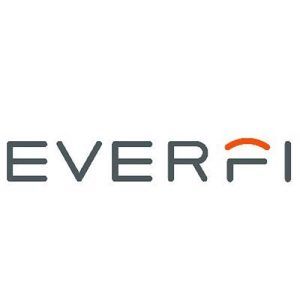Three Experts Share Their Advice for the Months Ahead
Rising inflation and interest rates, stock market turmoil, an end of government support during the pandemic, and countless other financial setbacks have coalesced into a bleak economic environment for consumers.
While many of these consumers are unprepared for a possible recession, financial institutions have a responsibility – and opportunity – to help educate these consumers on how to weather these storms.
Through a panel discussion, we asked experts to weigh in on how financial institutions can use this downturn as an opportunity to strengthen relationships with consumers and commercial partners. EVERFI’s VP of Strategic Partnerships, Ryan Swift, moderated the discussion with our panelists, who included:
- Mimi Joy, Head of Partnerships at the Financial Health Network;
- Freda Lee, Senior Vice President, Relationship Management at Corebridge Financial (formerly AIG); and
- Richard Knight, Co-founder and Managing Partner at Global Leader Group and former executive at HSBC.
Here, we’ll share the four key themes that emerged from the discussion and how financial institutions can not only help their audiences survive during these challenging times but also position themselves as a trusted resource and long-term supportive partner.
1. Measure the Financial Health of Your Communities
Before crafting a customer outreach strategy, institutions need to gather a clear picture of their communities’ current financial health. Financial institutions can use a number of tools to measure financial health, but one format the Financial Health Network utilizes is tiering consumers into three broad categories:
- Financially Healthy
- Financially Coping
- Financially Vulnerable
Financially healthy consumers manage their day-to-day expenses, absorb financial shocks, and progress toward meeting their long-term financial goals. Those who are financially coping pay most of their bills on time and have near-prime credit scores, but they may struggle with long-range financial planning or lack adequate insurance products. Financially vulnerable individuals struggle in all categories of their financial health.
According to The Financial Health Network’s annual Pulse research report, 2022 saw the largest shift of healthy respondents moving to the financially coping tier. This data, combined with the trend indicating that people are saving less and spending more, underscores that this downturn has impacted nearly every demographic, no matter a customer’s financial standing.
Marginalized communities stand to face measurably worse outcomes as well. Black and Latinx individuals, single-parent households, women, LGBTQIA+ folks, those with disabilities, and those who have faced historic disinvestment or ongoing discrimination are at increased risk of financial adversity. It’s crucial to focus on vulnerable consumers and tailor solutions to their particular pain points.
2. Meet Consumers Where They Are
Broadly identifying the trends and financial health of your consumers is an important first step in understanding how to support them. The next step is to assess the specific challenges of each audience and commit to meeting them where they are.
Financial institutions often develop consumer-facing tools or support structures without truly understanding their client’s financial literacy or motivations. This leads to time and energy wasted on solutions that aren’t effective or relevant for their intended audiences.
Instead, organizations should focus efforts on offering financial education services that are accessible to all – whether that’s online, in person, or through one-to-one consultations. “Providing financial education is critical before you get to a downturn,” says Freda Lee, Senior Vice President, Relationship Management at Corebridge Financial. “Consumers need to be able to have financial plans in place so they can address both expected and unexpected expenses.”
Not only should financial institutions provide the tools in an accessible way, but they should also use language that connects their audience instead of alienating them. It’s easy for financial institutions – who live and breathe the importance of financial health – to default to the language they use in their daily work.
“But the average consumer doesn’t think about these topics all day, every day”, says Freda. “Consumers need frequent reminders, and in ways they can understand – ways they can identify with as they’re making financial decisions for their households.” Skip the jargon and instead use simple, approachable language and practical reminders that will encourage consumers to build healthy habits.
3. Connect with Consumers in Three Key Ways
Since the fallout of the 2008 economic crisis, consumers have expected much more from their financial institutions. Rather than retreating and protecting the bottom line, leaders must step up and support their audiences across the board. This includes employees as well, who will be facing increased challenges in the coming months as this downturn progresses.
When communicating with your audiences during difficult times, Co-founder and Managing Partner at Global Leader Group, Richard Knight, recommends following a three-step framework to help individuals feel seen, understood, and supported.
- Reassure: Acknowledge the struggles of both consumers and employees, and recognize the unique challenges they may be facing due to their background. Offer encouragement that you’ll get through this difficult period together.
- Educate: The more knowledgeable a customer is, the better for your business. Share how your organization can support them and what’s available to them – either immediately through products and services, or longer-term through education and support. Help them build the muscles of habits like saving and putting money into retirement.
- Deepen: Think about the longer-term relationship. While no one knows exactly how long this downturn will last, we know it will end. The institutions that reach out in times of difficulty will be better prepared when we see the upside again.
Communicating with consumers in these three ways will help financial institutions foster trust, establish themselves as a valued long-term partner, and connect with their audiences in meaningful ways during uncertain times.
4. Get Ahead of the Message and Communicate Proactively
A strong relationship isn’t just responsive, it’s proactive. Each panelist was emphatic in their recommendations to get in front of consumers in creative, interactive ways. Richard noted that firms using financial tool activity and account analytics to understand how to approach clients most effectively are especially setting themselves apart.
To become a trusted resource to consumers, financial institutions need to have more regular, proactive communication. This can take the form of reaching out with timely resources, as well as establishing lines of two-way communication. Here are a few examples of how organizations can reach out and become more trusted in their communities:
- Conduct surveys
- Host educational webinars
- Offer cost-of-living saving guides
- Hold in-branch events for customers in marginalized communities
Challenging periods are where relationships and reputations are built or broken. Financial institutions can use this downturn as an opportunity to distinguish their services and brand and strengthen their community. “Institutions that offer this level of bespoke support,” says Freda, “will see greater long-term value from their consumers and colleagues – ultimately fortifying their bottom line.”
Key Takeaways
- Measure the financial health of your customers, employees, and communities. Understand if they are financially healthy, coping, or vulnerable, and adjust your product and service offerings based on what you learn.
- Speak the language of your consumers, and meet them where they are. While we, as financial institutions, think about financial health regularly, most consumers aren’t, and they need simple language and reminders to help them build the muscles of financially healthy habits.
- Reassure, Educate, and Deepen relationships with consumers. Acknowledge the impact of these financial hardships, share what solutions are available to them, and reach out in times of both difficulty and prosperity to build a stronger long-term relationship.
- Be proactive in your outreach. Now is not the time to hunker down or run away from consumers. Get out there and run your programs – educational webinars and in-branch events to reach marginalized communities.
To learn more about how to support your consumers, watch the full panel discussion at https://learn.everfi.com/webinar-prepare-communities-for-recession.









